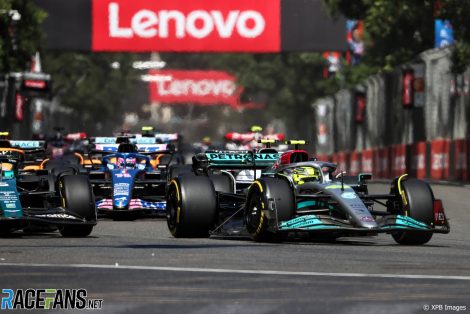The FIA has stopped enforcing a limit on the severity of ‘porpoising’ by Formula 1 cars, but is prepared to reintroduce it if required.
The potential risk of porpoising to drivers became a concern following the introduction of new technical regulations last year. The high levels of downforce generated by the floors of the redesigned cars led to many of them oscillating up and down on their suspension, a phenomenon known as porpoising.
In reaction the FIA devised an Aerodynamic Oscillation Metric to monitor the severity of the phenomenon and impose a limit on it. This came into force from the Belgian Grand Prix as part of an update to Technical Directive 039.
The FIA is continuing to use the AOM to monitor porpoising by the cars which teams are racing this year. However having observed a reduction in the severity of porpoising in general, it stopped enforcing the limit as of the first race of the season in Bahrain earlier this month.
Teams were told of the change in enforcement of the rules. RaceFans understands they have been advised that if the phenomenon worsens the FIA is prepared to reintroduce the limit. This could be done quickly, as the apparatus to monitor porpoising is already in place.
The restrictions on porpoising were required on safety grounds, the FIA said when they were introduced, explaining it “decided to intervene following consultation with its doctors in the interests of safety of the drivers”.
“In a sport where the competitors are routinely driving at speeds in excess of 300km/h, it is considered that all of a driver’s concentration needs to be focused on that task and that excessive fatigue or pain experienced by a driver could have significant consequences should it result in a loss of concentration,” it continued. “In addition, the FIA has concerns in relation to the immediate physical impact on the health of the drivers, a number of whom have reported back pain following recent events.”
Advert | Become a RaceFans supporter and
However some teams questioned the need for the limit when it was introduced, arguing that the extent of porpoising was already in decline and would continue to diminish. Red Bull team principal Christian Horner claimed rival reams exaggerated the extent of the problem and criticised the use of a metric to set a limit on porpoising.

“Hopefully it’s only something that will be there for this year as it’s something that hopefully all teams will be on top of as I’m sure the cars will converge next year,” he said last July. “It’s certainly not a precedent that we want to go down otherwise set-ups will be being dictated by FIA directives.”
At least one team feared it would exceed the metric during the 2022 season. McLaren gave a series of messages to Lando Norris during the Singapore Grand Prix urging him to change his line to reduce the risk of exceeding the limit.
Since the new season began several teams have reported they have encountered fewer problems with porpoising, notably Mercedes who suffered the problem most acutely last year. But others have suggested the problem hasn’t been entirely eradicated.
“It’s definitely better than this time last year, but it’s not gone,” said Valtteri Bottas during pre-season testing in Bahrain. “It is still there and you still need to compromise a bit with the set-up. It seemed with most of the cars that some sections of the track it’s still there and still a little issue that one needs to deal with.”
Become a RaceFans Supporter
RaceFans is run thanks in part to the generous support of its readers. By contributing £1 per month or £12 per year (or the same in whichever currency you use) you can help cover the costs of creating, hosting and developing RaceFans today and in the future.
Become a RaceFans Supporter today and browse the site ad-free. Sign up or find out more via the links below:
Advert | Become a RaceFans supporter and
















